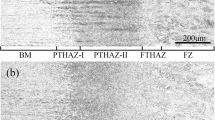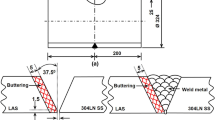Structural features, mechanical properties, and stressed state of welded joints of the TiAl system intermetallic compound (Nb, Cr, Zr) after electron-beam welding and subsequent electron-beam local heat treatment are determined. It was shown that stresses generated immediately after welding contributed to the appearance of cold cracks in the weld. Residual stresses in welded joints were determined using the technology and compact equipment based on the method of electronic speckle interferometry created at the Paton Electric Welding Institute of the National Academy of Sciences of Ukraine. It was found that after electron-beam welding, due to rapid cooling of the weld metal, phase transformations occurred, which deteriorated its mechanical characteristics. A method was developed for the local heat treatment of a welded joint by an electron beam immediately after the end of the welding process. Parameters of the local heat treatment process can significantly reduce the cooling rate, maintaining the temperature of the welded joint for 5 min at the level of 900°C. This can significantly reduce the level of residual stresses in the weld and contribute to the formation of a favorable three-component structure: γ-phase, (γ + α2)-phase and β-phase, which increases the weld ductility. A study of mechanical properties during the compression test of the weld showed that after local heat treatment, the yield strength of the weld was improved, while the tensile strength and degree of deformation under compression increased significantly. The proposed local heat treatment is effective and economically justified, which allows to reduce residual welding stresses by 30%, thus preventing the formation of cracks in welds, as well an improving structural and mechanical characteristics.





Similar content being viewed by others
References
A. V. Kartavykh, E. A. Asnis, N. V. Piskun et al., “A promising microstructure/deformability adjustment of β-stabilized γ-TiAl intermetallics,” J. Mater. Lett., 162, 180–184 (2016).
A. V. Karavykh, E. A. Asnis, N. V. Piskun, et al., “Microstructure and mechanical properties control of γ-TiAl (Nb, Cr, Zr) intermetallic alloy by induction float zone processing,” J. Alloy. Compd., 643, 182–186 (2015).
B. E. Paton (Ed.), Electron-Beam Welding [in Russian], Naukova Dumka, Kiev (1987).
V. S. Zolotarevskii, Mechanical Testing and Properties of Metals [in Russian], Metallurgiya, Moscow (1974).
K. B. Povarova and O. A. Bannykh, “Principles of creating structural alloys based on intermetallics. Part I,” Materialovedenie, No. 3, 27–33 (1999).
A. A. Il’in, B. A. Kalachov, and I. S. Pol’kin, Titanium Alloys. Composition, Structure, Properties [in Russian], VILS-MATI, Moscow (2009).
L. M. Lobanov, V. A. Pivtorak, V. V. Savitskii, et al., “Routine quality and stress state monitoring of welded structures by electronic shearography and speckle interferometry,” Avtomat. Svarka, No. 8, 39–44 (2005).
L. M. Lobanov, V. A. Pivtorak, V. V. Savitskii, and G. I. Tkachuk, “Procedure for determining residual stresses in welded joints and structural elements using electronic speckle interferometry,” Avtomat. Svarka, No. 1, 25–30 (2006).
R. Jones and C. Wykes, Holographic and Speckle Interferometry: A Discussion of the Theory, Practice and Application of the Techniques, Cambridge University Press, Cambridge (1989).
A. I. Kovtunov and S. V. Myamin, Intermetallic Alloys [in Russian], TGU, Togliatti (2018).
Author information
Authors and Affiliations
Corresponding author
Additional information
Translated from Problemy Prochnosti, No. 1, pp. 23 – 29, March – April, 2020.
Rights and permissions
About this article
Cite this article
Lobanov, L.M., Asnis, E.A., Piskun, N.V. et al. Structure, Mechanical Properties, and Stressed State of Weld Joints of the Tial(Nb, Cr, Zr) Intermetallic System. Strength Mater 52, 199–204 (2020). https://doi.org/10.1007/s11223-020-00166-x
Received:
Published:
Issue Date:
DOI: https://doi.org/10.1007/s11223-020-00166-x




